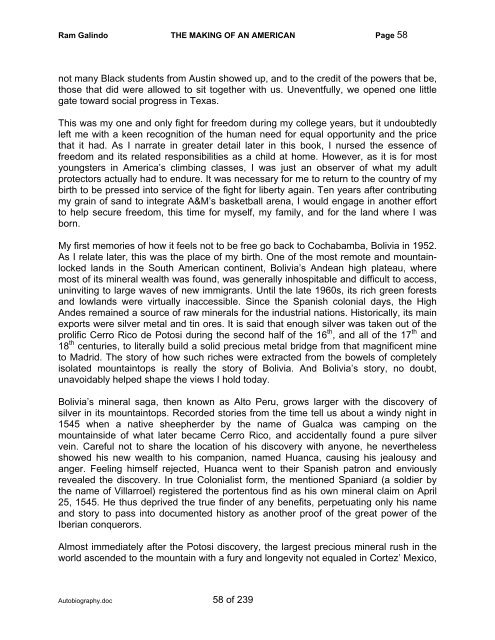Autobiography - The Galindo Group
Autobiography - The Galindo Group
Autobiography - The Galindo Group
You also want an ePaper? Increase the reach of your titles
YUMPU automatically turns print PDFs into web optimized ePapers that Google loves.
Ram <strong>Galindo</strong> THE MAKING OF AN AMERICAN Page 58<br />
not many Black students from Austin showed up, and to the credit of the powers that be,<br />
those that did were allowed to sit together with us. Uneventfully, we opened one little<br />
gate toward social progress in Texas.<br />
This was my one and only fight for freedom during my college years, but it undoubtedly<br />
left me with a keen recognition of the human need for equal opportunity and the price<br />
that it had. As I narrate in greater detail later in this book, I nursed the essence of<br />
freedom and its related responsibilities as a child at home. However, as it is for most<br />
youngsters in America’s climbing classes, I was just an observer of what my adult<br />
protectors actually had to endure. It was necessary for me to return to the country of my<br />
birth to be pressed into service of the fight for liberty again. Ten years after contributing<br />
my grain of sand to integrate A&M’s basketball arena, I would engage in another effort<br />
to help secure freedom, this time for myself, my family, and for the land where I was<br />
born.<br />
My first memories of how it feels not to be free go back to Cochabamba, Bolivia in 1952.<br />
As I relate later, this was the place of my birth. One of the most remote and mountainlocked<br />
lands in the South American continent, Bolivia’s Andean high plateau, where<br />
most of its mineral wealth was found, was generally inhospitable and difficult to access,<br />
uninviting to large waves of new immigrants. Until the late 1960s, its rich green forests<br />
and lowlands were virtually inaccessible. Since the Spanish colonial days, the High<br />
Andes remained a source of raw minerals for the industrial nations. Historically, its main<br />
exports were silver metal and tin ores. It is said that enough silver was taken out of the<br />
prolific Cerro Rico de Potosi during the second half of the 16 th , and all of the 17 th and<br />
18 th centuries, to literally build a solid precious metal bridge from that magnificent mine<br />
to Madrid. <strong>The</strong> story of how such riches were extracted from the bowels of completely<br />
isolated mountaintops is really the story of Bolivia. And Bolivia’s story, no doubt,<br />
unavoidably helped shape the views I hold today.<br />
Bolivia’s mineral saga, then known as Alto Peru, grows larger with the discovery of<br />
silver in its mountaintops. Recorded stories from the time tell us about a windy night in<br />
1545 when a native sheepherder by the name of Gualca was camping on the<br />
mountainside of what later became Cerro Rico, and accidentally found a pure silver<br />
vein. Careful not to share the location of his discovery with anyone, he nevertheless<br />
showed his new wealth to his companion, named Huanca, causing his jealousy and<br />
anger. Feeling himself rejected, Huanca went to their Spanish patron and enviously<br />
revealed the discovery. In true Colonialist form, the mentioned Spaniard (a soldier by<br />
the name of Villarroel) registered the portentous find as his own mineral claim on April<br />
25, 1545. He thus deprived the true finder of any benefits, perpetuating only his name<br />
and story to pass into documented history as another proof of the great power of the<br />
Iberian conquerors.<br />
Almost immediately after the Potosi discovery, the largest precious mineral rush in the<br />
world ascended to the mountain with a fury and longevity not equaled in Cortez’ Mexico,<br />
<strong>Autobiography</strong>.doc 58 of 239


